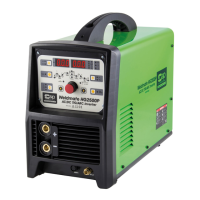8
least 10 metres away and out of the reach of sparks and heat or protect
against ignition with suitable and snug fitting, fire resistant covers or shields.
Walls touching combustibles on opposite sides should not be welded on, walls,
ceilings and the floor near the work area should be protected by heat resistant
covers or shields.
Openings (concealed or visible) in floors or walls within 10 metres may expose
combustibles to sparks.
Combustibles adjacent to walls, ceilings, roofs or metal partitions can be ignit-
ed by radiant or conducted heat.
After the work is done, check that the area is free of sparks, glowing embers and
flames.
An empty container that has held combustibles, or that can produce flamma-
ble or toxic vapours when heated, must never be welded, unless the container
has first been cleaned. Consult HSE INDG214, HSG250 and CS15. HSE docu-
ment CS15 includes information on cleaning by thorough steam or solvent/
caustic cleaning followed by purging and inserting with nitrogen, carbon diox-
ide or water filling just below working level.
A container with unknown contents should be treated as if it contained combus-
tibles (see previous paragraph), Do not depend on sense of smell or sight to
determine if it is safe to weld.
Hollow items must be vented before welding as they can explode.
Explosive atmosphere; Never weld when the air may contain flammable dust,
gas or liquid vapours (such as petrol).
SAFETY INSTRUCTIONS….cont
The welding arc produces ultraviolet (UV) and infrared (IR) rays as well as extreme tem-
peratures that can cause injury to your eyes and skin. Do not look at the welding arc
without proper eye protection.
The electric welding arc must not be observed with the naked eye. Always use a
welding mask; Ensure the welding mask is fitted with the correct shade of filter
lens for the welding current level, and covers the entire face from neck to the
top of the head.
Welding gauntlet gloves should be worn to protect the hands from burns, non-
synthetic overalls with buttons at the neck and wrist, or similar clothing should be
worn. Greasy overalls should not be worn. Wear suitable protective footwear.
Always wear correctly rated protective clothing which covers all areas of the
body; The operator should not weld with any bare skin showing to reduce the
chance of burns etc.
Avoid oily or greasy clothing, a spark may ignite them.
Hot metal such as electrode stubs and work-pieces should never be handled
GLARE AND BURNS
25
TROUBLESHOOTING
Note: If none of the above solutions work then contact your local distributor
for repair, or contact SIP technical for more advise.
Symptom Possible Cause Corrective Action
Cooling Fan Not Running. Cooling fan broken.
Cable damaged / fall-
en off.
Replace the fan.
Check cable and repair or
replace.
No Gas Output. No Gas Input.
Main PCB Faulty.
Electro-Magnetic Valve
Faulty.
Gas Path Blocked.
Check supply bottle is not
empty and the is regulator
is open.
Check and Replace The
PCB.
Check and Replace The
Valve.
Check and Clear Pipe and
Connections.
Fault Light Illuminated. Internal Temperature of
The Welder is Too High.
Thermal Relay is Faulty.
Over / Under Input Volt-
age is More than 15%.
Allow the Welder To Cool
Before Commencing
Weld.
Check and Replace Faulty
Relay.
Check the Input Supply.
Parameter Select / Adjust
Control Not Functioning.
Potentiometer Faulty.
Main PCB Faulty.
Cable damaged / fall-
en off.
Check and Replace Po-
tentiometer.
Check and Replace The
PCB.
Check cable and repair or
replace.
Main Display Blank. Display Faulty.
Cable damaged / fall-
en off.
Main PCB Faulty.
Replace Main Display.
Check cable and repair or
replace.
Check and Replace The
PCB.

